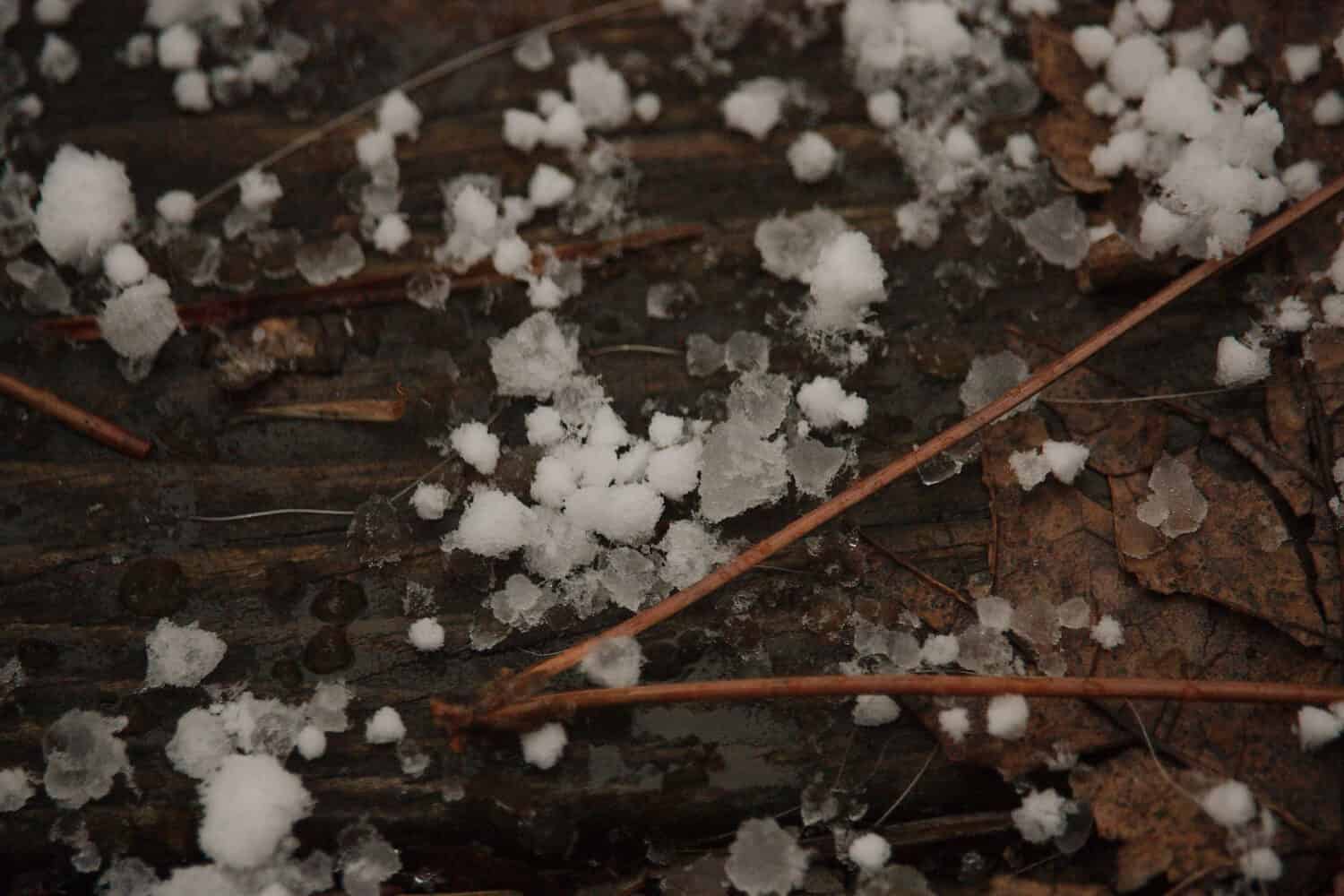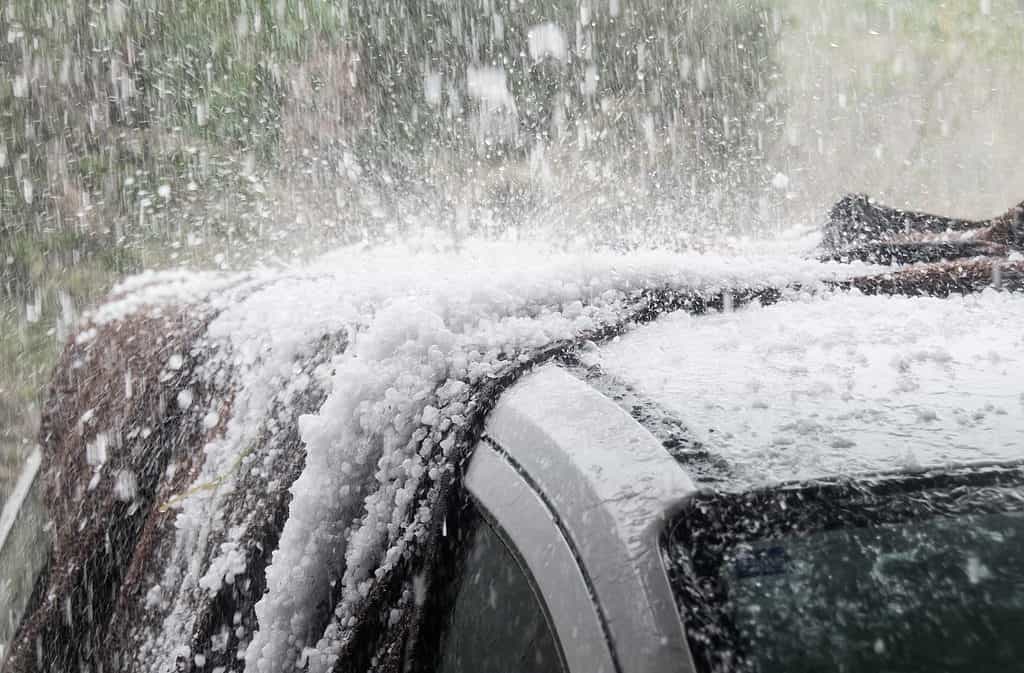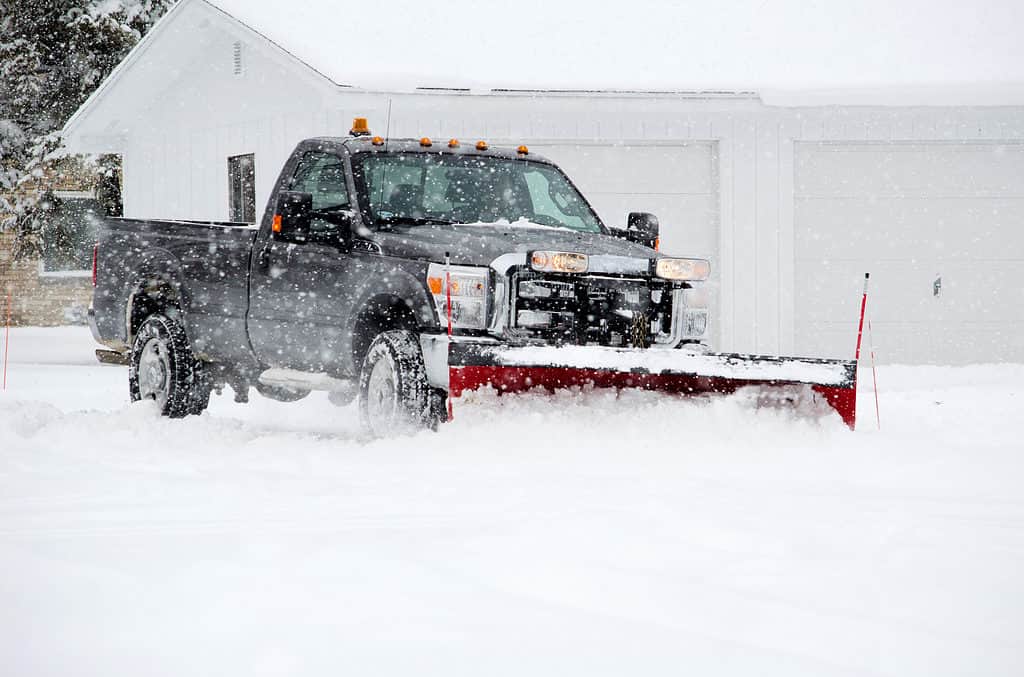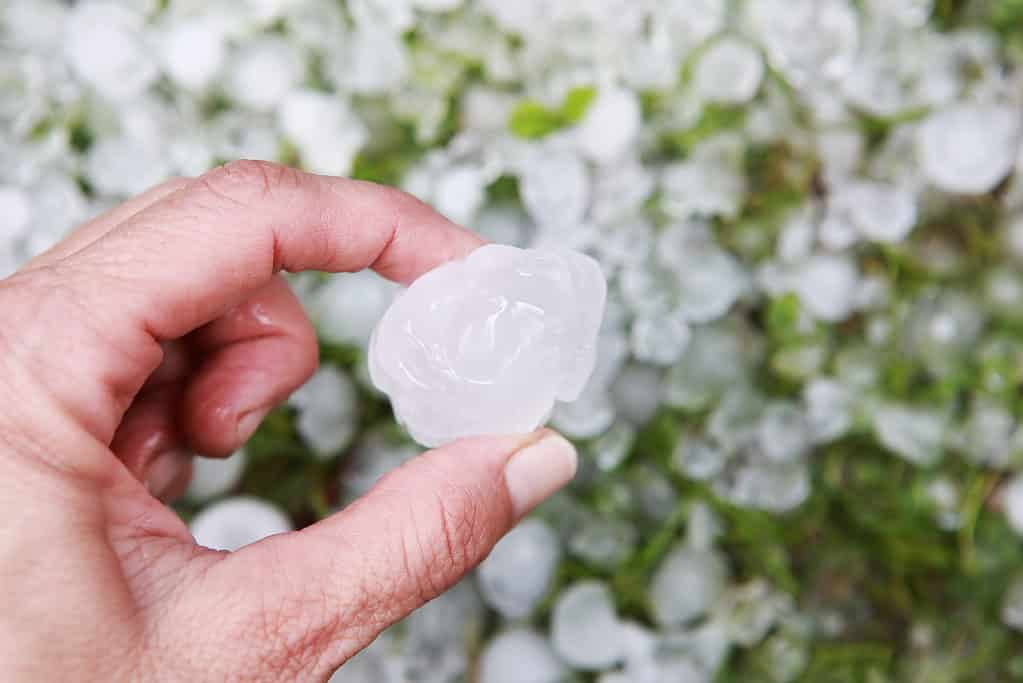No one wants to get caught out by sleet or hail. It’ll end in a drenching and potential injury depending on the severity of the storm, but do you know the difference? Sleet and hail are two different weather-related events, each with its own set of triggers and potential consequences. This article will delve into sleet vs. hail: three key differences and how to stay safe in each. We’ll finish off with the worst-ever sleet vs. hail storm.
What Is Sleet?
Sleet is solid precipitation. There’s no agreed definition, but it’s generally observed as a mix of rain and snow.
Snowflakes melt in the clouds and as they fall, creating a small pellet of melting ice that’s soft when it hits the ground.

Sleet consists of partially frozen snowflakes.
©Sharon Feragotti/Shutterstock.com
What Is Hail?
Hail is solid precipitation, but unlike sleet, it’s formed of solid ice. Hail falls and hits the ground in a frozen state. It’s hard and hurts and can potentially damage cars or other objects.

Hail is problematic since it is made of ice. It hurts and can potentially damage cars or other objects.
©Ben Romalis/Shutterstock.com
The Similarities Between Sleet and Hail
Both sleet and hail are frozen precipitation types (frozen rain).
What’s the Difference between Sleet and Hail?
Here are the three key differences between sleet and hail. Let’s look a little closer.
1. Time of Year
The first difference between sleet and hail is the time of year it falls.
Sleet forms in winter when the weather is cold, but hailstones can fall at any time at any time of year. Usually, hailstones fall during the spring, summer, and fall thunderstorms.

Sleet falls in winter during cold weather, while hailstones may fall at any time of year.
©Susan B. Sheldon/Shutterstock.com
2. How It Forms
Sleet and hail might be solid types of rain, but they form in vastly different ways.
How Sleet Forms
Sleet forms in a sky sandwich.
Rain begins as snow in a cloud top layer, which is very cold, then it passes through a warm layer (imagine that’s the cheese filling), where it partially melts back into semi-rain. Finally, the partially melted semi-rain refreezes as it passes through a cold bottom layer of cloud. When it emerges from the bottom layer, sleet falls to the ground.
The warmer middle cloud layer is pretty thin compared to the freezing top and bottom layers, so the snowflakes don’t get much time to melt back into the rain. That’s why sleet falls as soft ice pellets.
How Hail Forms
Hail forms in a totally different way to sleet.
Snow particles form in the freezing top layer of a thunderstorm. Thunderstorms are large, unstable storms heated by the sun. A thunderstorm has updrafts that whizz the tiny pieces of rain and ice upwards to freeze in the higher, colder air. They fall in the down drafts, collecting moisture and partially defrosting. Then, they are caught in updrafts where the extra moisture freezes. Then down and again, and so on. Hail forms in the multiple drafts. Eventually, hailstones grow too heavy for the updrafts and fall to Earth.
Powerful storms create powerful 160 km per hour updrafts capable of lifting heavy hailstones. This is when hail becomes dangerous.
3. Sleet vs. Hail: Danger Levels
Heavy hailstones, or multiple smaller hailstones, cause danger, but it’s not just their weight that’s dangerous; it’s the speed they fall. Small hailstones reach 10 mph, but large hailstones, ones the size of softballs, sometimes fall at over 100 mph.
The velocity and weight of large hailstones are enough to break glass, damage vehicles and houses, and even kill people. 19-year-old Juan Oseguaera suffered a head strike from a softball-sized hailstone in 2020. Sadly, he died from the injury.
In contrast, sleet is small and not heavy or fast enough to cause damage. Sleet dangers arise from accumulation on sidewalks and roads. Pedestrians and cars may slip or slide in heavy sleet, especially if the accumulation freezes over to form ice.
Sleet vs. Hail: How to Stay Safe
Sleet rarely causes danger. If you’re driving when sleet falls, it’s best to slow down, or if it’s very heavy, pull over until it stops. Iced-over sleet is hazardous for drivers and pedestrians, so slow down and wear appropriate footwear with lots of traction.
The most dangerous areas include bridges, elevated roads, and overpasses because they freeze from all sides and form sheet ice. Iced-over sleet on tree branches and powerlines may cause them to fall, but in general, sleet isn’t too much of an issue.
Hail, however, is a different story.
When hail falls, it’s best to get under cover. Hailstone can seriously damage not only homes and vehicles but you and your pets.
Powerful thunderstorms create large hailstones in multiple updrafts. If a powerful thunderstorm is predicted, bring in pets or livestock and make sure you have somewhere undercover to shelter when it breaks. Keep away from windows and skylights, and close curtains in case hailstones crack the glass.
Slow-moving thunderstorms cause hailstone accumulation, which is dangerous on roads. Don’t drive if a road is littered with hailstones because they prevent safe contact between tires and road surfaces.
Some experts suggest lightning strike is more likely during a hailstorm, so keep indoors to avoid a lightning strike and falling debris damage.

Hail is much more dangerous on the road than sleet, though you should be cautious when driving in both.
©Suzanne Tucker/Shutterstock.com
Record Breaking Sleet and Hail Storms
Softball-sized hail is not rare; many thunderstorms worldwide have produced large hailstones, but the largest ever recorded fell in South Dakota in 2010. This mega hailstone measured 18.65 inches in diameter and weighed 1.93 lbs.
This hailstone is incredible, but the thunderstorm that produced it was nothing compared to the deadliest hailstorm ever. The deadliest hailstorm ever happened in India’s Utter Pradesh state in April 1888. It was so ferocious it killed 246 people alongside 1,600 cattle and sheep with cricket ball-sized hail that reached two feet deep drifts.
Sleet rarely causes such damage, but in February 1883, the “Great Sleet” covered southeast Missouri, central Illinois, and northern Indiana in sleet that froze and created inch-thick ice.
Because temperatures remained below freezing for a week, the sleet didn’t melt. Ice brought down tree branches and telephone poles and cut off communications. When it eventually melted, the foot of frozen sleet caused extensive flooding damage.
How Do Sleet and Hail Affect Animals?
Sleet affects pets and wildlife in adverse ways. When sleet falls in winter, it’s wet and cold. This may cause hypothermia; if sleet freezes, it causes frostbite and food/water shortages. When it melts, frozen sleet may flood burrows and displace wild animals.
Hail causes injuries to cattle, pets, and wildlife. Large hailstones cause impact injury, and extended hailstorms dislodge nests from trees. This research shows hailstorms killed 35 bird species and nine mammal species in India’s Maharashtra region in 2014. The total number of dead birds by hailstone totaled 62,000.
Sleet vs. Hail: 3 Key Differences and How to Stay Safe in Each
We set out to examine the differences between sleet and hail and found three key differences.
How it’s formed: Sleet forms in a sandwich-style cloud, freezing, partially defrosting, and then freezing again before it hits Earth. Hail forms in thunderstorms’ up and downdrafts, growing larger with each updraft until it’s so heavy it falls.
When it’s formed: Sleet is more likely in winter, whereas hail is more likely in spring, summer, and fall.
Its danger level: Sleet isn’t dangerous when it falls, but accumulations may freeze over to create slippery ice. Hailstones pose more of a threat. Softball-sized hailstones cause injury, even death, to humans and animals and can severely damage property.
Either way, when sleet and hail fall, it is best to seek shelter and wait for clearer skies before heading outside again. Ensure pets and livestock have safe shelter, and keep your eyes peeled for injured wildlife. Rescue centers deal with weather-related wildlife injuries all year round, so don’t hesitate to ask for help.
Sleet vs. Hail: 3 Key Differences Table
| Hail | Sleet | |
|---|---|---|
| Danger level | Spring, Summer, and Fall | Dangerous if it freezes over |
| How it’s formed | In multiple updrafts and downdrafts of thunderstorms | Freezes, partially defrosts, and refreezes in sandwich-style winter rainclouds |
| When it’s likely | Spring, Summer, and Fall | Winter |
The photo featured at the top of this post is © Ben Romalis/Shutterstock.com
Thank you for reading! Have some feedback for us? Contact the AZ Animals editorial team.






